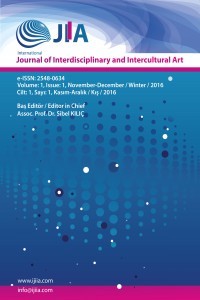
Uluslararası Disiplinlerarası ve Kültürlerarası Sanat
Yazarlar: Fatma Yelda GEZİCİOĞLU
Konular:-
Anahtar Kelimeler:Silk Weaving,Fabric Design,Experimental Weaving,Thin-Thick Yarn,Visual Effect and Texture
Özet: Various methods are used to create difference in the appearance on the surface of woven fabrics. One of these methods is yarn. The raw material of the yarn, its features and its use either as thin or thick yarn, and the order of arrangement of the yarns side by side generate a new visual effect for every weaving. The thin-thick arrangement of both weft and warp yarns creates different visual effects in the formation of volume and texture on the fabric surface, pattern and composition when placed in various ways such as dense or sparse, regular or irregular depending on the order of fineness and thickness in itself. While various images may be obtained on the surface based on the weave of fabric, colour factor and yarn density, it is also possible to say that different experimental applications may be conducted and many different designs may be obtained by harmonizing technique and aesthetics together. In this article, trials are made through the use of two different thicknesses and different arrangements and weavings of yarns made of silk raw materials. The same dobby and drafting were used in each study. Four different yarn arrangements have been applied in the warp and weft. In the whole study, 48 experimental weaves have been produced using three main weft (plain weave, twill, satin) in total. An experimental process is handled in the study where various surface effects are achieved with texture, volume, light, stain, transparency, line, square etc. images on the surface. It is aimed to contribute to textile designers/artists in terms of their original creations for creating a new look on the fabric surface in their work, with the patterned effect that the woven surfaces with different surface images in each experimental application will create on the surface in silk woven fabric design.